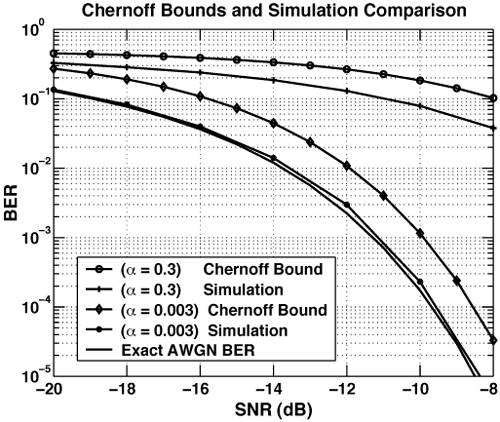Section 7.5. Interference Analysis: UWB on UWB
|
7.5. Interference Analysis: UWB on UWBUnder appropriate conditions, properly designed time-hopping and DS-CDMA type spreading codes can mitigate interference due to multiple users; however, in the presence of asynchrony, performance may degrade significantly. If the duty cycle is small or equivalently the load is light, that is, the number of active users Nu « Nf, random time hopping results in nearly orthogonal (or collision-free) low-rate multiple users. A transmitted symbol corresponding to Nf pulses per bit occupies a total of NfNc chip slots. In the traditional TH scenario, exactly one chip slot per frame (consisting of Nc chip slots) is non-zero. Generalizing this, we let ai, i = 0, ..., NfNc 1, denote the length NfNc spreading code. Rather than insisting that Nf chips be non-zero, we will require that the expected number of non-zero chips be aNfNc per symbol. Thus, we model ai as i.i.d. random variables, taking on values 1, 0,1 with probability mass function (PMF) Equation 7.46 where Figure 7.18. A Ternary Random Process Model (Pdf Shown at Bottom) May Be Used to Model Episodic Bipolar Pulsed Transmission. Cases with a < 0.5 (Top) Correspond to Episodic Transmission (Off-Times Between Pulses), Whereas a = 0.5 (Middle) Corresponds to a Conventional Binary Random Process Model (No Off-Times Between Pulses). This ternary PMF is very useful in capturing the effect of multiple access interference in a lightly loaded system. Specifically, if the user of interest is k, the receiver synchronizes itself to the k-th user's (random) hopping sequence, which it is assumed to know. Within any of the Nf active chips in a symbol, the receiver will see interference from one or more users. With Nu denoting the number of active users, the probability that any one given user causes a chip collision is 1/2a. The per-chip collision probability is then (Nu 1)/2a. The duty factor 1/2a effectively reduces the interference seen by the receiver. Let k = 0 denote the user of interest, with Nu being the total number of users. A Chernoff bound on the BER was derived in [39], and is given by Equation 7.47 where E0 is the desired user's energy per pulse, and Io denotes the effective interference, Equation 7.48 Note that the effective MUI is reduced by the duty cycle factor, 2a. In [39], this approach was used to obtain bounds on BER when training is used to obtain estimates of a random multipath UWB fading channel, which is then used in a RAKE receiver and in the presence of MUI.
Here, the time-hopping pattern was considered to be random and the modulation A-PAM. With the hop pattern modeled as deterministic, BER expressions have been derived for PPM in [45] assuming that the MUI is Gaussian, and in [38] without this assumption. |
|
EAN: 2147483647
Pages: 110

 10
10